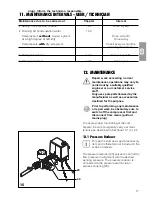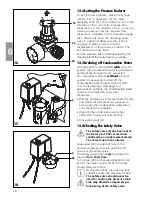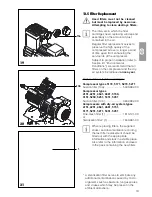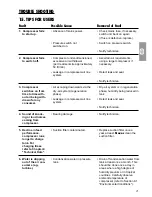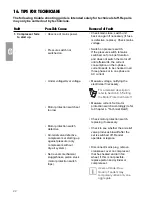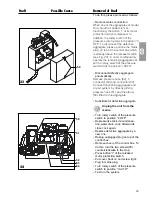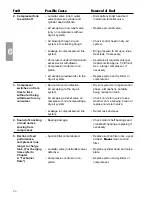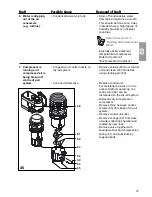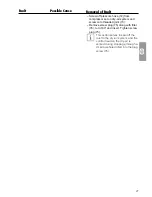
24
Possible Cause
• Lamellar valve (inlet / outlet
valve) between cylinder and
cylinder head defective.
• Air escaping on air-relief valve
(only on compressors without
dry-air system).
• Air blowing through dry-air
system into collecting trough.
• Leakage in compressed-air line
system.
• Compressor under-dimensioned;
excessive air withdrawal,
• Compression collar worn on
piston.
•
Air escaping downwards via the
dry-air system.
• Non-return valve defective.
Air escaping via the dry-air
system.
Air escaping at relief valve on
compressors not incorporating a
dry-air system.
• Leakage in compressed-air line
system.
• Bearing damage.
• Suction filter contaminated.
• Lamellar valve (inlet/outlet valve)
defective.
• Compression collar worn on
piston.
Fault
2. Compressor fails
to switch off.
3. Compressor
switches on from
time to time
without air being
withdrawn for any
consumer.
4. Sound of knocking
or loud noises
coming from
compressor.
5. Decline in feed
performance,
compressor runs
longer to charge
tank. (For charging
times refer to
Chapter
4. "Technical
Data").
Removal of Fault
• Dismantle cylinder head and
install new lamellar valve.
• Replace air-relief valve.
• Check control head on dry-air
system.
• Bring pressure to act upon lines.
Seal leak, if necessary.
• Ascertain air requirements (per
treatment site approx. 50 ltr/min).
Use a larger compressor, if
necessary.
• Replace piston and cylinder or
complete set.
• Dry-air system is in regeneration
phase; atmospheric humidity
being reduced in tank.
• Check non-return valve to see
whether air is escaping. Clean or
replace non-return valve.
• Detect leak and seal.
• Check motor shaft bearings and
crankshaft bearings, replacing if
necessary.
• Replace suction filter once a year
at least.
Never
clean suction
filter.
• Replace cylinder head and valve
plate.
• Replace piston and cylinder or
complete set.








